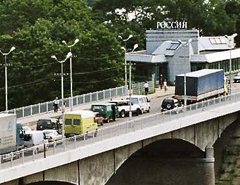
MOSCOW SIGNS BORDER AGREEMENT WITH ESTONIA
Publication: Eurasia Daily Monitor Volume: 2 Issue: 99
By:

On May 18 in Moscow, Ministers of Foreign Affairs Sergei Lavrov and Urmas Paet signed a long-awaited agreement on the Russia-Estonia border. The agreement had been initialed in 1996 and reconfirmed in 1999, its content fully approved by the Russian side in all details. However, Russia stonewalled the signing, as it did on the Russia-Latvia agreement. Moscow miscalculated that the absence of border agreements could impede those countries’ admission to NATO and the European Union. It also sought changes to Estonia’s and Latvia’s legislation on language and citizenship as a price for Russia’s signature on the border agreements. The situation changed fundamentally with the Baltic states’ accession to NATO and the EU in 2004, when the Estonia-Russia and Latvia-Russia borders became part of the EU-Russia border.
Last month, Russia’s Ministry of Foreign Affairs finally consented to sign the border agreement with Latvia as part of a complex set of unacknowledged linkages, involving the Latvian president’s attendance at the World War II victory anniversary celebrations in Moscow on May 9 and the EU-Russia summit on May 10. Russia continued stonewalling on the border treaty with Estonia (whose president declined to attend the Moscow celebrations). However, when the Latvian government attached an interpretative declaration to its treaty with Russia on April 29, Moscow reacted by refusing to sign that treaty, and unexpectedly inviting Estonia to sign the border treaty with Russia on May 18.
Moscow’s move is triply significant: First, as a bow to the inevitable in terms of Russia-EU relations; second, as an attempt at wedge-drawing between Baltic states, trying to isolate Latvia; and, third, as an indication that Russia’s Ministry of Foreign Affairs has become entangled in its own maneuvers, unable to control the dynamic of events.
The U.S. State Department, the EU’s Foreign and Security Policy chief Javier Solana, and External Relations Commissioner Bettina Ferrero-Waldner, and other authorities have welcomed the treaty signing, urged speedy ratification by the Russian and Estonian parliaments, and called for the signing of the Russia-Latvia border treaty as well, in the interests of Russia’s relations with its Baltic neighbors and the West.
The Estonia-Russia agreement consists of two documents, defining the border on land and in the Narva estuary and Gulf of Finland, respectively. Under the agreement, Russia obtains confirmation of its possession of two areas that were taken from Estonia and attached to the Russian SFSR during the occupation era: the town and environs of Iaanilinn (Ivangorod, opposite Narva) and the district of Petseri (Pechery, now in Pskov region). These areas made up 5% of Estonia’s territory prior to the occupation. Partly because of this issue, Moscow ruled out from the border agreement any reference to the 1920 Tartu Peace Treaty, which had recognized Estonia’s territorial integrity within the borders that included Iaanilinn and Petseri.
Today’s border divides the Setu people, a rural group closely related to Estonians ethnically and linguistically. Estonia is applying to UNESCO to include the Setu cultural heritage on both sides of today’s border on the Cultural Heritage List and offering to develop the area’s tourism potential. The Estonian government is offering to help Setu residents from the Russian side willing to relocate to the Estonian side of the border.
President Arnold Ruutel, Prime Minister Andrus Ansip, Paet, former president Lennart Meri, and most Estonian party leaders are calling for undelayed parliamentary ratification of the border agreement. Some political leaders, as well as Setu representatives, however, propose the adoption of an interpretative declaration that would refer to the Tartu Peace Treaty. This — like the 1920 Riga Treaty in Latvia’s case — is a cornerstone of the state’s legal continuity and, implicitly, of its territorial integrity as then constituted. It was mainly for these reasons that Moscow ruled out references to these Treaties from the border agreements with Estonia and Latvia. In that situation, Latvia apparently had no choice but to attach its interpretative declaration, in compliance with the Latvian constitution.
In what Moscow apparently deems a goodwill gesture, Lavrov no longer rules out the return of an Estonian state symbol, seized in 1940 and kept in the Kremlin: the presidential necklace and badge, worn by President Konstantin Pats, who died in a Soviet prison. Under Estonian law, presidents hand over that regalia to their successors. Meanwhile, Lavrov explicitly refused on May 18 the return of the renowned collections of Estonia’s Tartu University, which were carted off by Russian forces during the First World War. The items were subsequently stored in the Soviet Union and are now in the provincial museum of Voronezh. The Estonians have since 1992 sought the return of those collections.
(BNS, May 17-20; see EDM, May 2)




